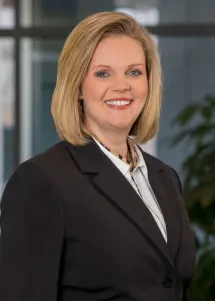HOME | ABOUT US | MEDIA KIT | CONTACT US | INQUIRE
HOME | ABOUT US | MEDIA KIT | CONTACT US | INQUIRE
Q. We’ve seen dire reports on a nursing shortage, but now enrollment trends are down in nursing schools. What’s your take on the current landscape?
These are tiny steps forward to fill the pipeline, but the schools are hurting, I believe that the interest in careers in nursing exists, but the challenge is with the shortage of faculty in schools of nursing to help teach students.
A. Specific within our organization, when COVID first hit, we saw a spike in nurse turnover. That has kind of leveled off. We had steady turnover for the duration of the pandemic for fairly consistent reasons—people jumping into travel nursing because of the high rates of pay, retirements, stress/burnout and fear of personal safety for themselves and their families. And some were just feeling undervalued and needed to step away from nursing.

Corporate Chief Nursing Officer Amy Peters, RN, BSN, MBA, at University Health. Photo: University Health
Q. Is the worst of that over?
A. We’re seeing some of those who left for travel nursing jobs starting to come back, and some who needed to step away are starting to come back. That has been fantastic. We’ve hired quite a few nurses back into our nursing workforce, which is slowly helping put the overall workforce back together.
Q. COVID only added to a longer-standing challenge, didn’t it?
A. Yes, we had a shortage before the pandemic, and the pandemic exacerbated it. We were not different from any organization in the country in that regard, but I’m starting to feel better now that some coming back.
Q. Are you keeping an eye on nursing-school enrollment trends and potential downstream effects?
A. This is actually one of the great things about our organization, leveraging our medical status and partnerships to focus on growing the next generation of nurses. We have partnerships with universities throughout the metro area, providing tuition discounts, matching scholarships, and recently, we’ve concentrated efforts on positions internally—student nurse externs—on the theory that they can earn while they learn.
Q. What results are you seeing from that?
A. For students in the nursing program, what we provide is real-life working experience with incredibly flexible schedules, because we recognize that these are students first. We establish a relationship between the organization and those students, so when they approach their senior year and complete their capstone with us, they know at time of graduation that they have a job with University Health and they are 100 percent comfortable because they’ve been with us so long.
Q. Even if you’re able to hold onto current workers, the longer-term challenge seems daunting.
A. These are tiny steps forward to fill the pipeline, but the schools are hurting, I believe that the interest in careers in nursing exists, but the challenge is with the shortage of faculty in schools of nursing to help teach students. We have partnered with UMKC’s School of Nursing and have staff nurses who also serve as clinical instructors in the nursing school. We are trying to be creative in what we do to support the program. One other thing is that because we are hiring new nurses, we have programs in place to support their transition into practice, establishing a foundation that contributes to the retention of those nurses in the long run.